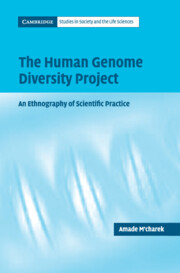Book contents
- Frontmatter
- Contents
- Preface
- 1 Introduction
- 2 Technologies of population: making differences and similarities between Turkish and Dutch males
- 3 Ten chimpanzees in a laboratory: how a human genetic marker may become a good genetic marker for typing chimpanzees
- 4 Naturalization of a reference sequence: Anderson or the mitochondrial Eve of modern genetics
- 5 The traffic in males and other stories on the enactment of the sexes in studies of genetic lineage
- 6 Technologies of similarities and differences, or how to do politics with DNA
- Glossary
- References
- Index
1 - Introduction
Published online by Cambridge University Press: 06 July 2010
- Frontmatter
- Contents
- Preface
- 1 Introduction
- 2 Technologies of population: making differences and similarities between Turkish and Dutch males
- 3 Ten chimpanzees in a laboratory: how a human genetic marker may become a good genetic marker for typing chimpanzees
- 4 Naturalization of a reference sequence: Anderson or the mitochondrial Eve of modern genetics
- 5 The traffic in males and other stories on the enactment of the sexes in studies of genetic lineage
- 6 Technologies of similarities and differences, or how to do politics with DNA
- Glossary
- References
- Index
Summary
The researcher in the field
On December 15 1996, I went to Munich Airport to meet a professor in population genetics. She had travelled from Tel Aviv to visit the laboratory where I was conducting my research. After we had found each other in the crowd, we took the train back into the city. Professor B.-T. turned out to be a very pleasant person and quite soon we found ourselves in animated conversation. She told me about the rare DNA samples that she had brought along and where she had collected them. The members of the laboratory were looking forward to the samples, specifically because they were running short of male samples from these populations. She had heard that I too was going to use the samples for my research project. I told her about my study and what I had uncovered so far. At the same time, I started to feel a little uncomfortable. I felt the urge to “reveal” my “identity” to her. Because I was not just a member of the laboratory: I was also studying it. However, before I could do so, Professor B.-T. was eager to learn where I came from. I told her that I lived in Amsterdam but that I was originally from Tunisia. A little shy but curious, she asked me whether I was also from “one of those interesting populations.”
- Type
- Chapter
- Information
- The Human Genome Diversity ProjectAn Ethnography of Scientific Practice, pp. 1 - 20Publisher: Cambridge University PressPrint publication year: 2005
- 1
- Cited by

